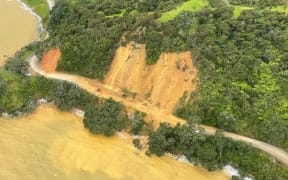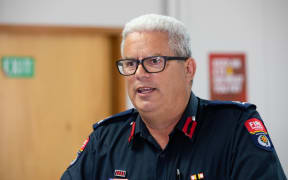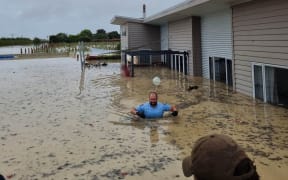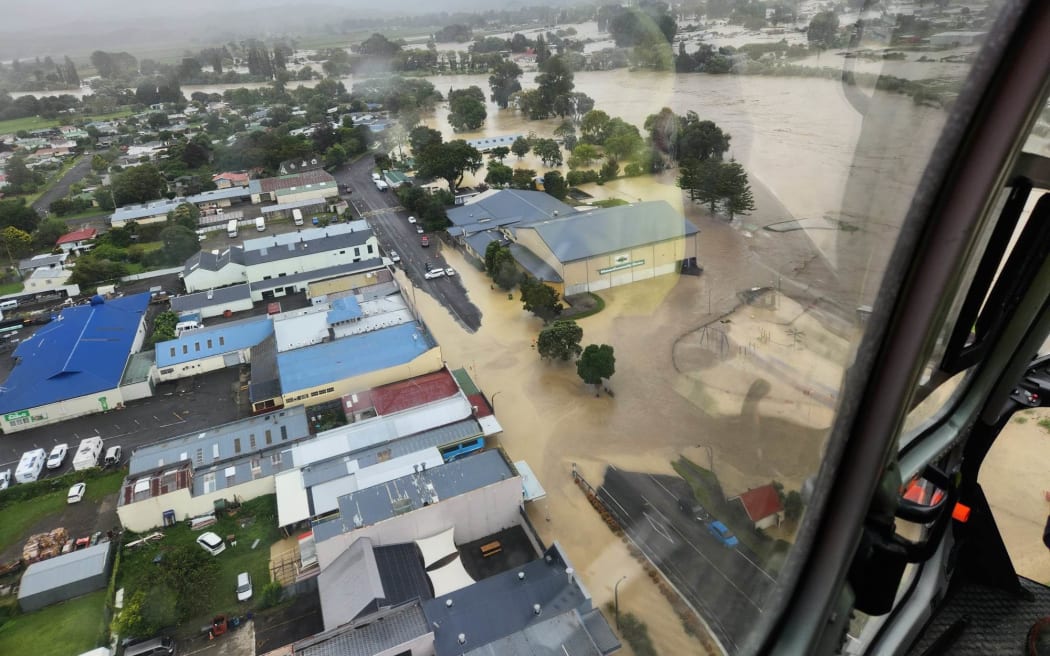
Wairoa in northern Hawke's Bay after the Wairoa River burst its banks. Photo: Hawke's Bay Civil Defence Emergency Management Group
Wairoa in northern Hawke's Bay after the Wairoa River burst its banks.
Emergency Management Minister Kieran McAnulty says the Defence Force is working to get food and water to Wairoa in Hawke's Bay.
He told Morning Report communication to the town had been restored via Civil Defence, police and Fire and Emergency.
Wairoa was a black hole on Tuesday, with cellphones, landlines and internet all down, and the lone satellite phone had run out of battery.
Late Tuesday night, Wairoa District Council sent an email to media advising a Star Link internet terminal had been activated, allowing them to send limited information to authorities outside the town.
McAnulty said the fact that Wairoa was cut off was causing a great deal of concern.
"When we know what the need is we're confident we can meet it, but when we can't get into a community it's hard to know what the need is and how much damage there is."
However, McAnulty said he was feeling a lot more optimistic about the situation there than he was on Tuesday.
Power has been restored to Wairoa Wednesday morning and contact has been made with its Civil Defence centre, as well as being able to get information via local police and Fire and Emergency, he said.
"We're in a much better position to be able to understand the need there, we know that they need food, we know that they need water and with the weather clearing we're going to be able to utilise probably the Defence Force to get in the supplies they need."
Power had mostly been restored in Gisborne which allowed communications to be restored, although on Wednesday morning there were still around 700 households without power, he said.
"Many of the mobile towers that had fallen out it was because they were linked to power. So yesterday there were 225,000 properties without power, this morning I was briefed that it was 144 - that's progress but it's still a lot of households without power."
Telecommunications Forum chief executive Paul Brislen said the fact that power was being restored in areas around Hawke's Bay would allow cell phone towers to run again.
"Once they're powered, we can get them [the towers] back up and running relatively easily I'm told."
A lot of generators were shipped into the Hawke's Bay region ahead of Cyclone Gabrielle, but the problem was getting fuel to them due to the damaged roads, he said.
"We're also looking at moving in satellite back haul services today, hopefully later on this morning, that will provide connectivity out to the rest of the world, not a huge amount of bandwidth, we're talking about phone calls and text messages but at least it's a step in the right direction for the people of the Hawke's Bay."
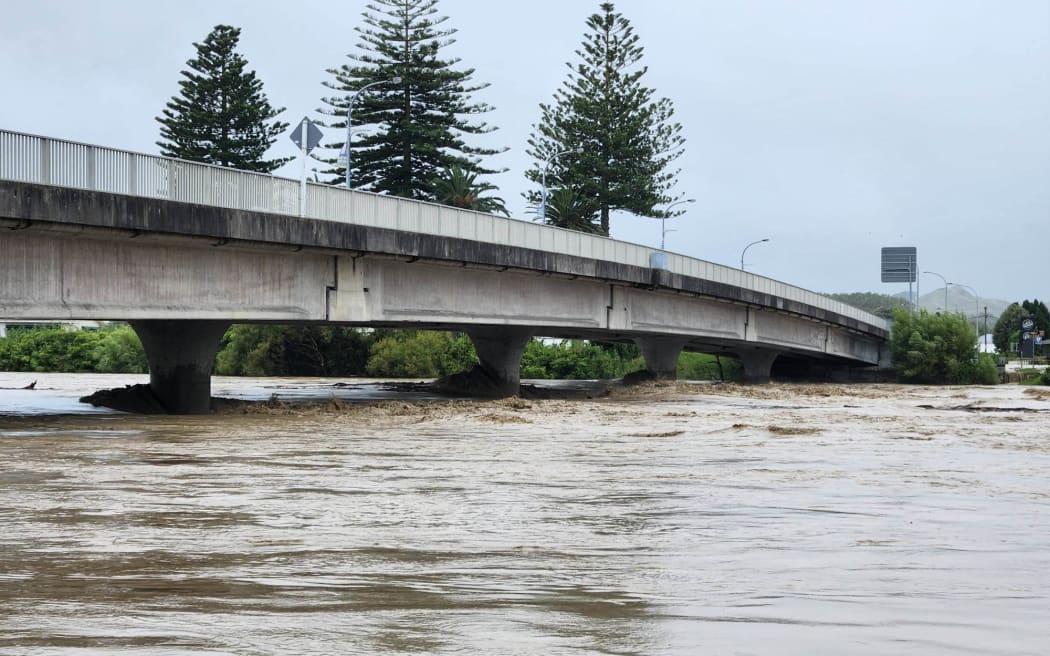
A bridge in Wairoa where the river burst its banks, inundating houses in the cut-off northern Hawke's Bay town. Photo: Hawke's Bay Civil Defence Emergency Management Group
Transpower says challenging to get full power restored to Hawke's Bay
Transpower says it will be challenging to get full power supply restored to the Hawke's Bay region.
In Hastings and Napier, about 60,000 people are without power, and it could be days or weeks before power is returned to all customers, after Transpower's Redclyffe substation was flooded.
Chief executive Alison Andrew said the Unison and Eastland distribution companies also had "massive damage" to their networks.
Crews have not yet able to get to the Redclyffe substation site because of flooding and a helicopter was coming up from Wellington on Wednesday to try to get into the site.
Transpower was reconfiguring its network in an attempt to have Unison able to use electricity coming in from the south, and could potentially bypass the substation to have power from the north getting in to the region, Andrew said.
The substation has electricity coming in from the Taupō area. It was built in 1927, refurbished in 1970, and was designed to withstand a one-in-100 year flood. But severe weather was "proving to be difficult".
Brislen said whether cell phone communications could be restored in areas was largely dependent on the power supply, and the Telecommunications Forum was working with the power companies to bring services back online as quickly as possible.
Restoring coverage would be much more difficult in cases where fibre cables had been cut due to damaged infrastructure such as bridges, Brislen said.
"It looks very much like there's a lot of damage to the fibre network, the crews are only starting to be able to get to the sites hopefully today and tomorrow.
"So we've got to do the assessment phase, we've got to work out whether it's part of a larger civil works project, you know if a bridge needs to be rebuilt, and then from there we can start the restoration."
Immediate priority assessing needs of isolated communities - McAnulty
McAnulty said the national state of emergency allowed coordination across the country and the Defence Force, Fire and Emergency and police had assured the government they had sufficient resources nationally to meet the demand in affected areas.
The national state of emergency would be reviewed every seven days, he said.
The recovery phase of dealing with the disaster would be long and slow, he said.
"This is not going to be a quick fix and it's not going to be cheap but we're committed to do it."
Wednesday's priority was to get a full grasp of what was needed in all the communities that had been isolated, he said.
McAnulty said he was now more confident they would be able to do having established contact with all local Civil Defence organisations.
"It was incredibly uncomfortable for everybody not knowing exactly what was needed, we're confident we'll be able to get a grasp of that now we've established communications with all local civil defence - once we know that we've got to get them what they need."
National Emergency Management Agency advice:
- Put safety first. Don't take any chances. Act quickly if you see rising water. Floods and flash floods can happen quickly. If you see rising water do not wait for official warnings. Head for higher ground and stay away from floodwater.
- Do not try to walk, play, swim, or drive in floodwater: even water just 15 centimetres deep can sweep you off your feet, and half a metre of water will carry away most vehicles.
- Throw away food and drinking water that has come into contact with floodwater as it is often contaminated and can make you sick.
- If you see a downed power line or damaged power equipment please stop, retreat and stay well clear.
- Stay at home if it is safe to do so and have an evacuation plan in case your home becomes unsafe to stay in.
- If you have evacuated, please stay where you are until you are given the all-clear to go home.
- People should stay up to date with the forecasts from MetService and continue to follow the advice of civil defence and emergency services.
- A National State of Emergency is in place for an initial period of seven days and applies to regions that have declared a local State of Emergency.
